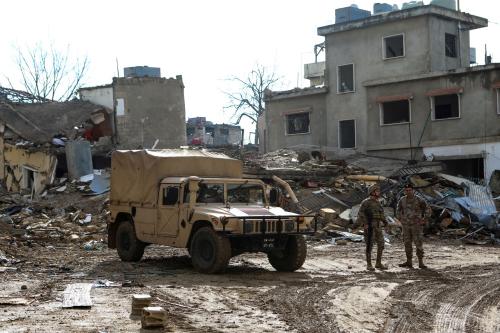Will the weapon of choice of today’s insurgents also be the weapon of tomorrow? That is the question posed by new data on the proliferation of improvised explosive devices (IEDs).
While the IED is sometimes described as a new technology, it actually has a lengthy history. Ships loaded with explosives were used as far back as the 1500s, while various jury-rigged bombs and mines were used in our own Civil War, such as at the naval battle of Mobile Bay and the land battle of Petersburg. Even the “new” version of IEDs — whose explosively formed penetrators can pierce even the armor plating of the U.S. military’s mine-resistant vehicles — actually dates back to World War II.
But the use of such weapons in the past was fairly limited and certainly without strategic consequences. The very name “improvised” was originally meant as a sort of putdown. An IED was used when you couldn’t get something better, not something to be widely emulated. This turned with Iraq and Afghanistan, where the weapons helped neutralize the U.S.’s overwhelming advantage. They proved particularly effective against softer military targets such as Humvees, trucks and foot patrols, as well as civilians, and became the signature weapon in those wars. Last year in Afghanistan, they caused just over half of U.S. military deaths, according to iCasualties.org.
But what has gone relatively unnoticed is that the number of IED attacks outside these two nations has doubled over the past three years. The first nine months of 2011 saw an average of 608 attacks per month in 99 countries, according to the Defense Department.
The implications are manifold. The first is that the danger will not disappear even after the U.S. campaign in Afghanistan ends. The IED has proved to be a cheap, relatively easy-to-use tool against both civilians and advanced militaries. And so it will continue to be copied. The IED is not disappearing; rather it is proliferating.
This means that we need to stop visualizing the weapon as a tool only for insurgents or groups affiliated with al-Qaida or the Taliban. There have been many actual or attempted homemade bomb attacks inside the U.S. — a substantial number made by people who couldn’t find Mecca on a map. A good example is the Spokane, Wash., plot in January 2011. Kevin Harpham, a white supremacist affiliated with the National Alliance group, recently pleaded guilty to placing a shaped charge, designed to emit a blast of shrapnel covered with rat poison (which would have kept victims’ wounds from coagulating) along a parade route for the Martin Luther King holiday. Disaster was averted when a parking lot maintenance man discovered the bomb just 30 minutes before the parade. While the incident received far less media coverage than it would have were it connected to al-Qaida, Harpham’s IED would have likely hurt more people than any other terrorist incident inside the United States since 9/11.
An enduring threat requires an enduring capability to counter it. With their growing and spreading use, however, IEDs present increasingly difficult balance-of-costs problems. The United States has spent roughly $17 billion on various anti-IED gear over the last decade, and that’s not counting the $45 billion we’ve spent on mine-resistant vehicles. We have to figure out how to alter the investment ratio. This is not just a budgeting issue. It is unsustainable to keep throwing billions of dollars to fight a technology that costs the other side tens of dollars. We need not silver-bullet solutions but ones that are cheap and scalable.
The second challenge is that much of our effort has gone toward the IEDs of yesterday and today, rather than where they are headed tomorrow. We have spent billions of dollars to develop and buy gear that deals with relatively simple IEDs, the kind that are usually buried in the dirt in rural regions. We have, for example, made great advances in standoff metal detection and can now spot a single piece of metal along a dirt road in Afghanistan.
The problem is not every future battlefield will resemble the rural villages that Alexander the Great fought over 2,000 years ago. We need to ensure our countermeasures also work in the more likely urban battle zones of the future. City streets, for example, tend to have more metal in them than rural dirt roads. Thus, the key investments will not just be to find more cost-effective systems but ones that can handle any IED in any locale. These include systems that detect the telltale chemical residue at a distance.
Finally, we need to prepare for weapons that get up and move. While today’s IEDs are generally planted in dirt, we have seen modified ground robotic ones used in Iraq and attempts at aerial ones inside the United States. In September, the FBI arrested Rezwan Ferdaus, who allegedly plotted to load an explosives-packed, remote-controlled aircraft the size of a small car into the Pentagon. The hard part reportedly was not getting the technology of a drone. Rather, according to authorities, Ferdaus made the mistake of asking an FBI informant where to get C-4 explosive.
When it comes to how we think about IEDs, we need to face facts: Threats evolve, even improvised ones.
The Brookings Institution is committed to quality, independence, and impact.
We are supported by a diverse array of funders. In line with our values and policies, each Brookings publication represents the sole views of its author(s).



Commentary
The Evolution of Improvised Explosive Devices (IEDs)
February 7, 2012